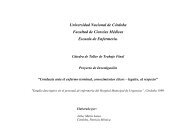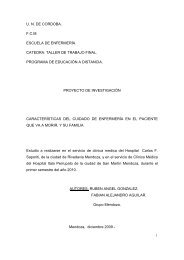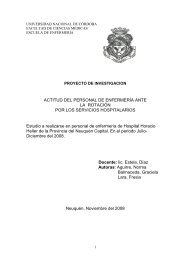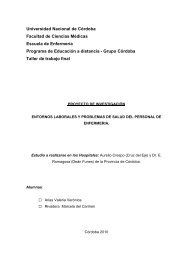manual para estudiantes de medicina - Escuela de Enfermería
manual para estudiantes de medicina - Escuela de Enfermería
manual para estudiantes de medicina - Escuela de Enfermería
Create successful ePaper yourself
Turn your PDF publications into a flip-book with our unique Google optimized e-Paper software.
Manual AIEPI <strong>para</strong> <strong>estudiantes</strong> <strong>de</strong> Medicina<br />
bebió. Cuando el profesional pellizcó la piel <strong>de</strong>l abdomen el pliegue volvió muy lentamente a<br />
su posición original.<br />
♦ En la parte correspondiente a la pregunta ¿Tiene el niño diarrea? Debe tildar SI.(1)<br />
♦ Anote en ¿Cuánto tiempo hace?: 3 días.(2)<br />
♦ Luego circule letárgico (3), ojos hundidos (4), no pue<strong>de</strong> beber (5) y vuelve el pliegue muy<br />
lentamente (6) ya que Fátima presentó estos signos durante la evaluación.<br />
♦ Al clasificar <strong>de</strong> acuerdo al Cuadro <strong>de</strong> Procedimientos, usted pue<strong>de</strong> observar que los<br />
signos <strong>de</strong> Fátima clasifican como DESHIDRATACIÓN GRAVE. Anote dicha clasificación (7)<br />
en el margen <strong>de</strong>recho <strong>de</strong>l formulario.<br />
Entonces el Formulario <strong>de</strong> Registro quedará confeccionado <strong>de</strong> la siguiente forma:<br />
Ejemplo 9: Parte superior <strong>de</strong>l Formulario <strong>de</strong> Registro con el síntoma principal <strong>de</strong> diarrea.<br />
F ORMULARIO DE REGISTRO DE ATENCIÓN DEL NIÑO <strong>de</strong> 2 MESES A 5 AÑOS DE EDAD<br />
20/6/2002<br />
Nombre::___Fátima___ Edad__18 meses_ Peso:__11,5 Kg_ Talla: __79.5cm____ Temperatura axilar:__37,5___°C<br />
PREGUNTAR:¿qué problemas tiene el niño?¿_ tos y dificultad <strong>para</strong> respirar__ Visita Inicial? _ Visita <strong>de</strong> seguimiento:<br />
EVALUAR (Encerrar en un círculo todos los signos presentes) CLASIFICAR<br />
VERIFICAR SI HAY SIGNOS DE PELIGRO GENERAL<br />
¿Hay algún signo general <strong>de</strong><br />
peligro?<br />
EL NIÑO NO PUEDE BEBER O TOMAR EL PECHO LETÁRGICO O COMATOSO<br />
Sí _√_ No ___<br />
VÓMITA TODO CONVULSIONES Recuer<strong>de</strong> usar signos <strong>de</strong><br />
peligro cuando seleccione las<br />
clasificaciones<br />
CONVULSIONES<br />
¿TIENE EL NIÑO TOS O DIFICULTAD PARA RESPIRAR? Sí _√__No__<br />
¿Cuánto tiempo hace? 7_días -Contar las respiraciones por minuto. NEUMONIA<br />
__41_ respiraciones por minuto. Respiración rápida<br />
Si tiene sibilancias: -Cianosis<br />
¿Primer episodio?<br />
¿Recurrente?<br />
- Observar si hay tiraje subcostal<br />
-Determinar si hay estridor.<br />
-Determinar si hay sibilancias (si la hay evalúe primero)<br />
¿TIENE EL NIÑO DIARREA? Sí __√_(1) No__<br />
¿Cuánto tiempo hace? __3__Días(2) -Determinar el estado general <strong>de</strong>l niño.<br />
¿Hay sangre en las heces? DESHIDRATACION<br />
GRAVE (7)<br />
¿Letárgico o inconsciente? (3)<br />
¿Inquieto o irritable?<br />
-Determinar si tiene ojos hundidos (4)<br />
-Ofrecer líqudos al niño:<br />
¿Bebe muy mal o no pue<strong>de</strong> beber? (5)<br />
¿Bebe ávidamente con sed?<br />
-Signo <strong>de</strong>l pliegue cutáneo: la piel vuelve al estado anterior<br />
¿Muy lentamente (más <strong>de</strong> 2 segundos?<br />
¿lentamente? (6)<br />
-Relleno capilar mayor <strong>de</strong> 3 segundos<br />
53








